The baby and adult CPR instructions contained in this site are only a reference on how to perform CPR. They are not intended to be your only guide. Everybody should be properly trained for CPR by qualified instructors. Many people believe that a drowning is a result of water in the lungs. This is a misconception. Drowning occurs when the water in the air passage blocks air flow to the lungs. Therefore, suffocation kills the drowning victim. When the victim is pulled from the pool, or other body of water, the water in the stomach, air passage or in the mouth will be expelled by the movement. If the rescuer believes that water still remaining in the victim would make performing CPR difficult, the victim should be turned on his side to allow for any water to drain out. Once a pulse has been restored and the victim is breathing after CPR has been performed, the victim should be put on his side again in case of vomiting. There are different methods of CPR, depending on the age of the victim. They are described as follows:  Determine that you have a victim. Ask the victim, “Are you all right? Can you speak?” Shake the victim gently by the shoulders. If there is no response, have someone call 911 immediately. | 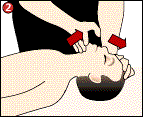 Open airway using head tilt-chin lift. Place upper hand on victim’s forehead, pushing it back. Fingers on lower hand go on victim’s jawbone, directly under chin, helping to raise it. | 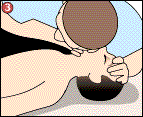 Check for breathing. This must be done in three to five seconds and is a three-way check. Rescuer’s ear is close to victim’s mouth to hear breathing; feel warm air on cheek; see movement in victim’s chest. | 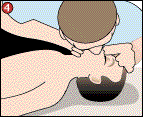 Begin breathing. Seal the victim’s nostrils with thumb and index finger of upper hand. With a firm seal around victim’s mouth, breathe twice, each inhalation one to 11/2 seconds. | 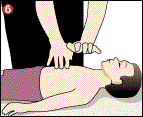 Check carotid pulse. Use the tips of two fingers on the side of the neck closest to the rescuer and check for five to 10 seconds. Do not use the thumb because it has its own pulse. | 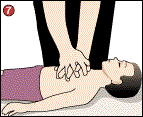 Prepare for chest compressions. Find notch at the bottom of the breastbone. Place the heel of upper hand two finger-widths above the lower hand. | 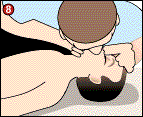 Begin compressions. Place lower hand on upper hand and interlace fingers and give 15 compressions within nine to 11 seconds. | Ventilate twice. Inspiration again should be one to 11/2 seconds. Repeat procedure of 15 compressions and two ventilations each four times. Check carotid pulse for five seconds. |
| | |